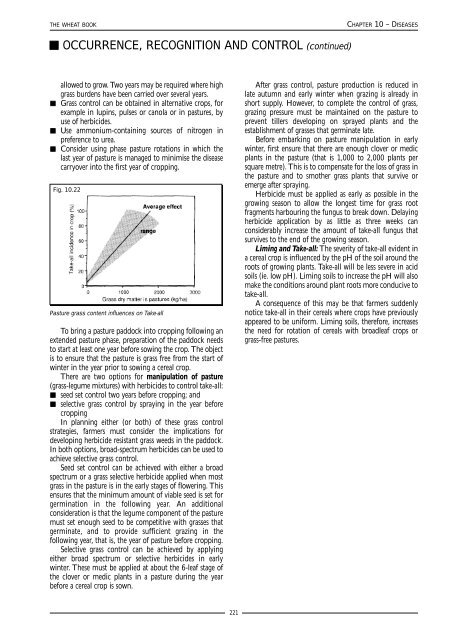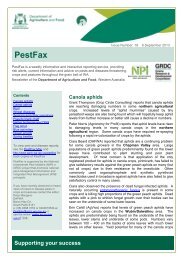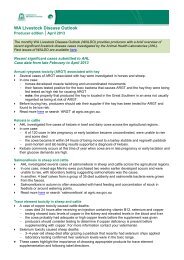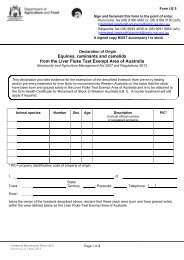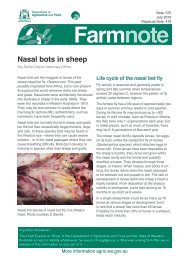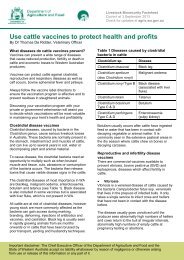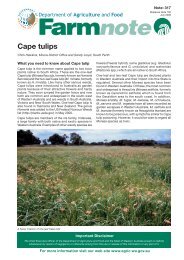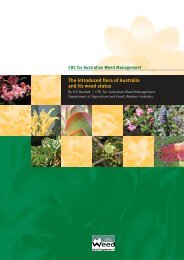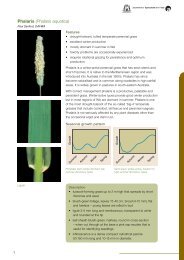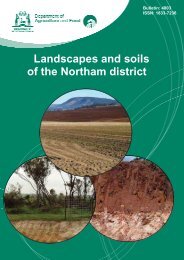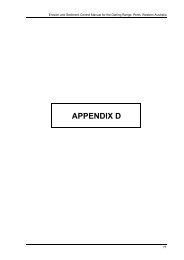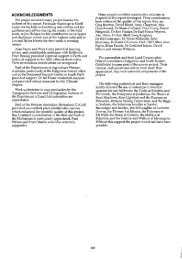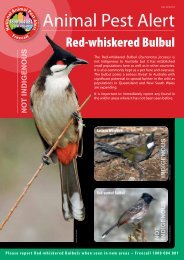The wheat book : principles and practice - Department of Agriculture ...
The wheat book : principles and practice - Department of Agriculture ...
The wheat book : principles and practice - Department of Agriculture ...
You also want an ePaper? Increase the reach of your titles
YUMPU automatically turns print PDFs into web optimized ePapers that Google loves.
THE WHEAT BOOK CHAPTER 10 – DISEASES<br />
OCCURRENCE, RECOGNITION AND CONTROL (continued)<br />
allowed to grow. Two years may be required where high<br />
grass burdens have been carried over several years.<br />
Grass control can be obtained in alternative crops, for<br />
example in lupins, pulses or canola or in pastures, by<br />
use <strong>of</strong> herbicides.<br />
Use ammonium-containing sources <strong>of</strong> nitrogen in<br />
preference to urea.<br />
Consider using phase pasture rotations in which the<br />
last year <strong>of</strong> pasture is managed to minimise the disease<br />
carryover into the first year <strong>of</strong> cropping.<br />
Fig. 10.22<br />
Pasture grass content influences on Take-all<br />
To bring a pasture paddock into cropping following an<br />
extended pasture phase, preparation <strong>of</strong> the paddock needs<br />
to start at least one year before sowing the crop. <strong>The</strong> object<br />
is to ensure that the pasture is grass free from the start <strong>of</strong><br />
winter in the year prior to sowing a cereal crop.<br />
<strong>The</strong>re are two options for manipulation <strong>of</strong> pasture<br />
(grass-legume mixtures) with herbicides to control take-all:<br />
seed set control two years before cropping; <strong>and</strong><br />
selective grass control by spraying in the year before<br />
cropping<br />
In planning either (or both) <strong>of</strong> these grass control<br />
strategies, farmers must consider the implications for<br />
developing herbicide resistant grass weeds in the paddock.<br />
In both options, broad-spectrum herbicides can be used to<br />
achieve selective grass control.<br />
Seed set control can be achieved with either a broad<br />
spectrum or a grass selective herbicide applied when most<br />
grass in the pasture is in the early stages <strong>of</strong> flowering. This<br />
ensures that the minimum amount <strong>of</strong> viable seed is set for<br />
germination in the following year. An additional<br />
consideration is that the legume component <strong>of</strong> the pasture<br />
must set enough seed to be competitive with grasses that<br />
germinate, <strong>and</strong> to provide sufficient grazing in the<br />
following year, that is, the year <strong>of</strong> pasture before cropping.<br />
Selective grass control can be achieved by applying<br />
either broad spectrum or selective herbicides in early<br />
winter. <strong>The</strong>se must be applied at about the 6-leaf stage <strong>of</strong><br />
the clover or medic plants in a pasture during the year<br />
before a cereal crop is sown.<br />
221<br />
After grass control, pasture production is reduced in<br />
late autumn <strong>and</strong> early winter when grazing is already in<br />
short supply. However, to complete the control <strong>of</strong> grass,<br />
grazing pressure must be maintained on the pasture to<br />
prevent tillers developing on sprayed plants <strong>and</strong> the<br />
establishment <strong>of</strong> grasses that germinate late.<br />
Before embarking on pasture manipulation in early<br />
winter, first ensure that there are enough clover or medic<br />
plants in the pasture (that is 1,000 to 2,000 plants per<br />
square metre). This is to compensate for the loss <strong>of</strong> grass in<br />
the pasture <strong>and</strong> to smother grass plants that survive or<br />
emerge after spraying.<br />
Herbicide must be applied as early as possible in the<br />
growing season to allow the longest time for grass root<br />
fragments harbouring the fungus to break down. Delaying<br />
herbicide application by as little as three weeks can<br />
considerably increase the amount <strong>of</strong> take-all fungus that<br />
survives to the end <strong>of</strong> the growing season.<br />
Liming <strong>and</strong> Take-all: <strong>The</strong> severity <strong>of</strong> take-all evident in<br />
a cereal crop is influenced by the pH <strong>of</strong> the soil around the<br />
roots <strong>of</strong> growing plants. Take-all will be less severe in acid<br />
soils (ie. low pH). Liming soils to increase the pH will also<br />
make the conditions around plant roots more conducive to<br />
take-all.<br />
A consequence <strong>of</strong> this may be that farmers suddenly<br />
notice take-all in their cereals where crops have previously<br />
appeared to be uniform. Liming soils, therefore, increases<br />
the need for rotation <strong>of</strong> cereals with broadleaf crops or<br />
grass-free pastures.


